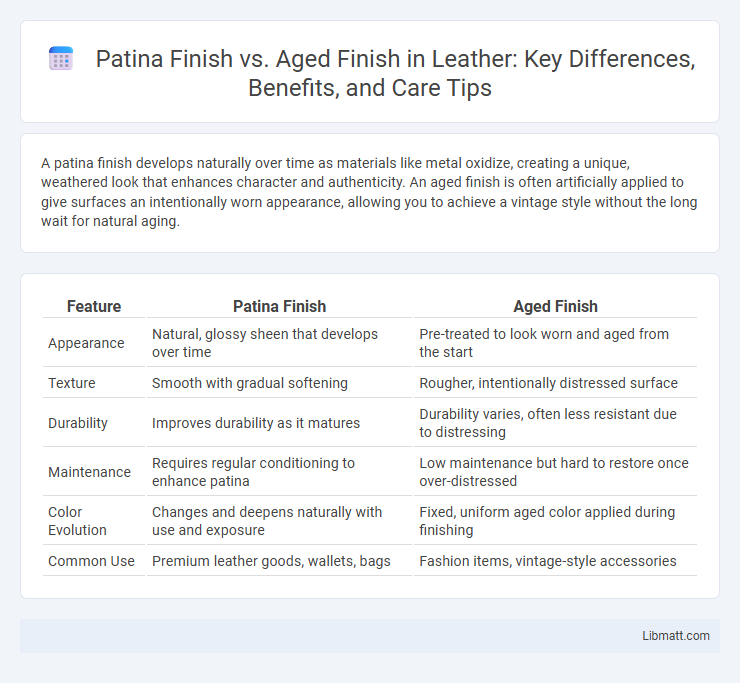A patina finish develops naturally over time as materials like metal oxidize, creating a unique, weathered look that enhances character and authenticity. An aged finish is often artificially applied to give surfaces an intentionally worn appearance, allowing you to achieve a vintage style without the long wait for natural aging.
Table of Comparison
| Feature | Patina Finish | Aged Finish |
|---|---|---|
| Appearance | Natural, glossy sheen that develops over time | Pre-treated to look worn and aged from the start |
| Texture | Smooth with gradual softening | Rougher, intentionally distressed surface |
| Durability | Improves durability as it matures | Durability varies, often less resistant due to distressing |
| Maintenance | Requires regular conditioning to enhance patina | Low maintenance but hard to restore once over-distressed |
| Color Evolution | Changes and deepens naturally with use and exposure | Fixed, uniform aged color applied during finishing |
| Common Use | Premium leather goods, wallets, bags | Fashion items, vintage-style accessories |
Understanding Patina Finish: Definition & Characteristics
Patina finish refers to the natural or artificially induced surface layer that develops on materials like metal or wood over time, characterized by color changes, texture variations, and a distinct aged appearance. This finish enhances the aesthetic appeal by highlighting the material's history and authentic wear, often desired for its unique and organic look. Understanding Patina finish helps you appreciate the subtle nuances that differentiate it from an aged finish, which may simulate wear without the same depth of natural development.
What Is an Aged Finish? Key Features Explained
An aged finish replicates the natural wear and tear on surfaces to evoke a sense of history and character, often achieved through distressing techniques like sanding, scratching, or applying dark stains. Key features include uneven coloration, visible imperfections, and a matte or low-sheen texture that mimics years of use. This finish contrasts with patina, which specifically develops through chemical reactions and oxidation, typically on metals like copper or bronze.
The Science Behind Patina Vs. Aged Finish
Patina finish develops through natural oxidation and chemical reactions on metal surfaces, creating a protective layer with unique coloration and texture over time. Aged finish, often achieved through artificial processes, simulates wear and tear by applying treatments that mimic rust, scratches, and discoloration without altering the metal's core properties. Understanding the science behind patina versus aged finish highlights how genuine environmental exposure influences metal durability and aesthetics compared to controlled, cosmetic aging techniques.
Popular Materials for Patina and Aged Finishes
Popular materials for patina finishes include copper, bronze, and brass, which develop unique green or blue-green layers due to oxidation. Aged finishes are often applied to wood, iron, and leather to simulate wear and time-induced texture, enhancing character and charm. Your choice between patina and aged finish depends on the material's natural aging properties and the desired visual effect.
Visual Differences: Patina Finish vs. Aged Finish
Patina finish develops naturally over time through oxidation, creating a smooth, often greenish or brownish layer that enhances the depth and character of materials like copper and bronze. Aged finish, on the other hand, is artificially applied to replicate the worn, weathered look of vintage items, featuring uneven textures and distressed markings that mimic years of use. Your choice between these finishes impacts the visual appeal, with patina offering authentic, organic aging and aged finish providing a controlled, stylized antique appearance.
Application Techniques Compared: Patina and Aged Finishes
Patina finish develops naturally or through chemical treatments that oxidize metal surfaces, requiring careful application of acids, waxes, or sealants to achieve desired color variations and texture. Aged finishes involve layering paint, sanding, and distressing techniques on wood or metal to simulate wear and time-induced marks, often using glazes or stains for depth. Understanding these application techniques allows you to select the perfect method to enhance your furniture or decor with authentic vintage character.
Durability and Maintenance: Which Finish Lasts Longer?
Patina finishes develop naturally over time, enhancing durability as the metal surface oxidizes and forms a protective layer that resists corrosion. Aged finishes, often artificially applied, may require more frequent maintenance to preserve their appearance and prevent wear. Your choice between patina and aged finish should consider the balance between long-term durability and upkeep effort.
Design Trends: Where Patina and Aged Finishes Shine
Patina finishes excel in design trends emphasizing natural aging and authentic character, often seen in industrial and vintage decor styles where the beauty of time-worn surfaces is celebrated. Aged finishes, by contrast, provide a more controlled, rustic appearance ideal for farmhouse, shabby chic, and traditional interiors seeking a deliberate weathered look. Your choice between these finishes can highlight either genuine aging or curated distress, influencing the overall ambiance and aesthetic appeal of your space.
Choosing the Right Finish for Your Project
Patina finish develops naturally over time or through chemical treatments, creating a unique, weathered look that enhances metal surfaces with authentic character. Aged finish is typically applied artificially to replicate wear and tear, offering a controlled vintage appearance that suits various design styles. Understanding the subtle differences between patina and aged finishes can help you choose the right option to complement Your project's aesthetic and durability requirements.
Cost Considerations: Patina versus Aged Finishes
Patina finishes generally involve natural oxidation processes or chemical treatments that can increase labor and material costs, whereas aged finishes often rely on manual distressing techniques that may be less expensive but more time-consuming. Your choice depends on budget constraints and the desired authenticity; patina can provide a unique, evolving look with potentially higher upfront costs, while aged finishes offer immediate visual effects at a potentially lower price point. Understanding these cost variables helps optimize your investment in surface treatments for furniture or metalwork projects.
Patina finish vs aged finish Infographic

 libmatt.com
libmatt.com